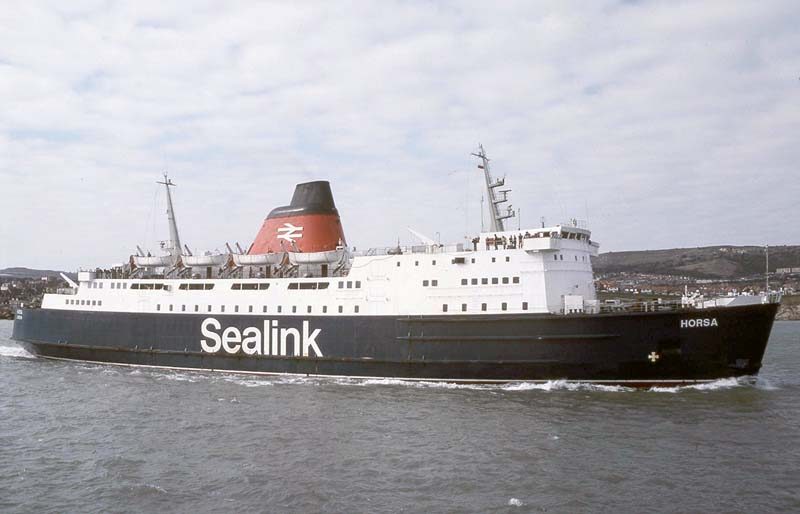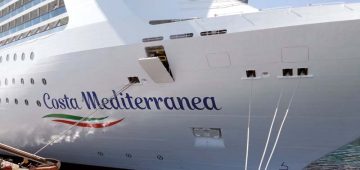Flight Of The Eagle
On 15th March Red Funnel’s 4,075gt/1996 built flagship Red Eagle returned to service between Southampton and East Cowes with a brand new look following an extensive £3 million interior refit. The refit mirrors the work carried out to Red Falcon (2014) and Red Osprey (2015) and was entrusted to Solent marine specialists Trimline, SMS and Wight Shipyard. The work involved the renewal of the passenger accommodation on B deck, the fabrication and fitting of two new stylish public lounges on A deck and new outside viewing space on AA deck. Later in 2018 the Red Jet 7 will join the fleet with a new freight ferry being delivered in 2019.
Option Taken
Finnlines announced on 20th March that it had decided to exercise the options to lengthen two more Ro-Ro vessels. The company’s €70 million Energy Efficiency and Emission Reduction Investment Programme was launched with the lengthening of four vessels in 2017, with an option of an additional two. The first two vessels, the Finntide and Finnwave, have already been operating in their extended forms. By the end of May 2018, a further two vessels, the Finnsky and Finnsun, will be lengthened, whilst the Finnbreeze and Finnsea will now be lengthened in September-December 2018. Each enlarged vessel will have a capacity increase of some 30%. After the modification the vessel is 217.7 metres long and has a capacity of around 4,200 lanemetres. In co-operation with DFDS, Finnlines has extended its Spain-Sweden service to Scotland, with the addition of roundtrip sailings between Bilbao and Rosyth.
Ferry Stuck
The Arctic Umiaq Line ferry Sarfaq Ittuk was beset by ice off the southwest coast of Greenland on 23rd March with 37 passengers and 22 crewmembers aboard. The 73m long ferry finally freed herself from an ice flow on 27th March and continued to Arsuk, arriving the next day. She then continued to Paamiut and Nuuk. Due to the location and the wind direction, it was not possible for other ships to sail to the Sarfaq Ittuk’s assistance. The risk of such an attempt would likely result in two ships stuck in the ice rather than just one. Although inconvenienced and without internet or phone service, passengers on board were never in any danger and seemed to take the weather delay in their stride. Throughout the ordeal, Arctic Umiaq Line kept in contact with the crew and communicated the status of the vessel directly with passenger’s families back home. The company also provided regular updates to Facebook, showing pictures of passengers and crew playing games, reading and watching movies. The 238 passenger/22 crew capacity and 2,118gt Sarfaq Ittuk was built in 1992 and underwent a renovation and extension in the winter of 1999-2000.
Cmal News
Caledonian Maritime Assets Limited (CMAL) has published an invitation to tender to identify a principal contractor to supply a new linkspan at Oban Ferry Terminal. The linkspan, which is the terminal’s original facility and is predominately used by the Mull ferry service, has reached the end of its serviceable life and needs to be replaced. The existing support structures will also be strengthened as part of the project. The contract will be delivered on site in February and March 2019. CMAL has also completed the extensive upgrade of Brodick Ferry Terminal, which opened to passengers on 20th March. Completion of the £30 million redevelopment project was unexpectedly delayed by an issue relating to the automated door closure on the passenger access system (PAS). The project was substantially complete in summer 2017, but the PAS failed to receive its CE mark certification and could not be used. The issue has now been resolved and CE mark certification is in place. The project has completely transformed the terminal, delivering a new pier, an increased marshalling area through reclaimed land and a modern terminal building, with bus stands and parking facilities. It is the single biggest port infrastructure construction project delivered by CMAL. The official opening ceremony took place on Thursday 12th April 2018. Ferry operations also began at the new terminal on 20th March 2018. Work to transform the harbour began on site in January 2016.

The Next Fsg Newbuild Commences
On 12th March white-hot plasma jets cut through sheets of steel at the FSG shipyard in Germany during the steel cutting ceremony marking the first step in the construction of Brittany Ferries’ new LNG powered cruiseferry Honfleur, a ship that will take little over a year to complete. By June 2019, the metal being cut on 12th March will form part of a complex and complete 42,400gt vessel serving the Portsmouth to Caen link. Steel cutting, of course, is not the start of the process. Before the Honfleur is built in steel, she is built virtually. Every other cut and weld has been carefully planned, along with the countless other operations required to build such a complex ship. For shipbuilding in the 21st century is as much about CAD design, complexity management and logistics as it is about forming steel. When complete, the Honfleur will carry up to 1,680 passengers, 550 cars and 64 trailers will offer 261 cabins, two cinemas, restaurants, boutique shopping and expansive passenger lounges. Wi-Fi will come as standard in all areas of the ship, including cabins and access from the car decks to passenger areas will be made as easy as possible for all passengers. She will be the first ferry regularly operating on the English Channel, powered by LNG. The project milestones are as follows:- Steel cutting: March 2018, Keel laying: August 2018, Launch: December 2018, Sea trials: March 2019, Delivery/naming ceremony: May 2019, Entry into service: June 2019.
Proposal Accepted
Damen has announced that the Government of Ontario has accepted its proposal to build two ferries with full electric propulsion. Damen is building a Road Ferry 6819 and a Road Ferry 9819 (68 metres and 98 metres respectively) to operate in the Canadian waters of the Great Lakes. The vessels will be the first fully electric, non-cable vessels in Canada. As part of the tender process for the contract to build the ferries, Damen was required to identify future innovations and green technologies for sustainable power solutions. Following careful consideration of the technology, the Government of Ontario has accepted Damen’s electrification proposal. It is estimated that electrification of the two ferries, serving Kingston and Wolfe Island and Millhaven and Amherst Island (Loyalist Township) respectively, will reduce emissions by the equivalent of 7 million kg carbon dioxide per annum.
Another Win For Island Yard
Wight Shipyard Co. of East Cowes, Isle of Wight, announced on 21st March that it had won an order from Mexican operator Ultramar for two 37m ferries, the first British vessels to be built for Mexico in living memory. Ultramar operates a fleet of ferries between Cancún, Isla Mujeres and Cozumel ports in the Quintana Roo Peninsula. Designed by Incat Crowther, the 37m long, 8.75m beam and 2.10m draught Ultramar twins will each provide accommodation for 459 passengers over three decks. Passengers will board the new craft on the main deck forward and aft, where a bright and airy cabin is capable of seating up to 169 passengers. This order follows on from the 41m Red Jet 7 ordered by Red Funnel, Scotland’s Jacobite Cruises order for a 21m day cruise catamaran for Loch Ness and the 39m high speed craft for passenger services between Vienna and Bratislava.
Project To Bring Home Cross-Channel Favourite


Sealink Historic Ferries are undertaking a massive project to rescue one of the former Sealink Ferries, the 5,108grt/1972 built Horsa (above), from demolition. The Horsa used to serve on the Folkestone/Dover to Boulogne/Calais routes among others. The ship was sold in 1992 to a Greek company who continued to operate her as a passenger ferry in the Mediterranean until 2013, since when the Penelope A has been laid up in a Greek port. The ship is the last remaining of a family of three ferries, her sister ships being the Senlac and Hengist which have now both long been scrapped.




Comments
Sorry, comments are closed for this item